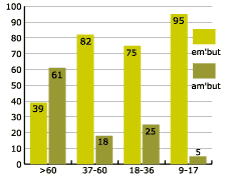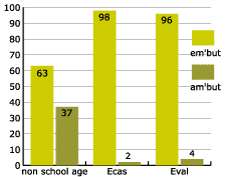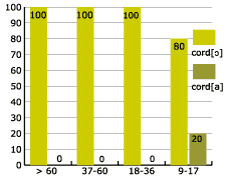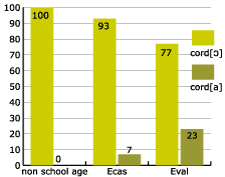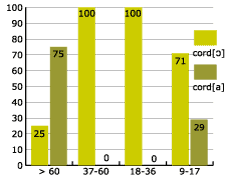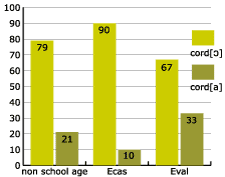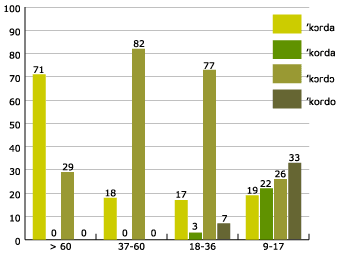
| Autumn 2003 |
Phonetic variation and standardisation in the Valencian Country, by Carles Segura Llopes |
||||
| In this article (1) we set out to show that the
incipient process of language normalisation which Catalan is undergoing has its
repercussions on traditional dialects such as that spoken in the county of Baix Vinalopó (2) and on its phonetic subsystem. In
addition to analysing the degree of penetration of the standard-normative variety in the
speech of the county, we shall look at the degree of acceptation or dereliction of the
traditional model, both those which are normative forms (that is, coincide with standard)
and those which are not, and also the penetration of the Spanish model.
|
|||
Summary 2.
Phonetic study 1. Introduction Our hypothesis on this study was that the incipient process of language normalisation which Catalan was having on the phonetic forms of the traditional dialect in the county of Baix Vinalopó was considerable, and especially on the language model used by schoolchildren, the social group most exposed to the normative or standard variety of Valencian Catalan (henceforth Catalan). For that reason it was a problem to decide on the criteria by which to select the linguistic features to test the hypotheses. Strict variationism recommends the choice of a single linguistic feature which is described and analysed in especial depth. Yet focusing exclusively on a specific feature would have caused us to lose sight of important linguistic elements participating in this change. Therefore, an in-depth variationist analysis of an individual linguistic feature was not appropriate. What we needed rather was a more general view, therefore, with less depth, but allowing us to obtain an overall view with plentiful (and representative) data. In this way, we would succeed in defining common overall tendencies, finding new patterns and new patterns of correction. Going into detail would have not allowed us to achieve this perspective. Characterising the phonetic model of the county of Baix Vinalopó which we will now put forward takes into consideration two social variables. On the one hand, there is age, a variable forming a dimension along which there is very noticeable linguistic variation. We distinguish four groups: a) the elderly —over 60—; b) adults —aged 37-60—; c) young people —18-36—; and d) schoolchildren —9-17. The second of these variables has to do with the degree of contact that individuals will have had with formal Catalan in the school. We look at 3 groups: a) individuals over 20 who had no schooling in Catalan (they are labelled no schooling in the graphs); b) individuals under 20 whose education has been mainly through the medium of Spanish, even though they have taken Valencian as a subject, and perhaps been taught one or two other subjects in Valencian Catalan (they are labelled Lval); and c) individuals under 20 whose education has been mainly through the medium of Catalan (we refer to these as Eval). We interviewed a total of 138 individuals, distributed in an approximately proportional manner according to the population of the localities and the divisions of the county of Baix Vinalopó. The linguistic questionnaire contained 55 items and the conditions under which the questionnaire was carried out could be described as semiformal. In this article we only present a part of the phonetic characterisation based on the questionnaire responses. 2.1 Three initial groups en–, em– and es– We will now look solely at the word embut ("funnel") since it is one of the few words that have traditionally maintained the pronunciation [am]but, typical of most of Western Catalan, almost all words that have en–, em– and es– in initial position are pronounced [e] in large part of the county. As we can see in figure 1, the realisation [am]but is not the only realisation amongst the elderly, but it is the predominant one. In the adult and young people groups, the frequency of the traditional form falls sharply, to an equal extent across the two groups, in favour of the innovation [em]but. Schoolchildren opt for the prestige form embut in some 95% of the cases. Figure 2 shows that the school curriculum creates little difference in the responses from the school children; indeed, the raising of [am]>[em] is to all intents and purposes complete and identical across the two groups.
There are two basic reasons that explain the swiftness of the change: a) the traditional form [am]but does not reflect the spelling in Catalan (or in Spanish); b) It is not pronounced this way in Spanish. Despite the fact that [am]but is the traditional pronunciation, the weakening of this pronunciation is intense throughout the county, and is already clearly present in the replies from the oldest generation. In conclusion, a weakening of this traditional pronunciation occurs because neither the written Catalan model nor that of the superstrate language —Spanish— give it support. 2.2 Progressive velar vocal assimilation: corda > The county falls into three divisions according to whether the traditional model has or does not have progressive velar vocalic assimilation: a) Guardamar and Crevillent show no sign of assimilation. b) The north-east of the county has assimilation throughout to a generalised degree. c) The rest of the county is in the process of change toward velar assimilation throughout —this includes the capital, Elx. In area b),
where assimilation is traditional (see graph 3), the three adult generations show no sign
of the The school children in the Eval category are the ones who show the greatest increase in the non-assimilated realisations, some 23%, compared to the 7% evinced by the Lval group (see figure 4). The pronunciation typical of traditional speech, therefore, is most vigorous in the Catalan of the group that have had least contact with the standard version of Catalan.
In area c),
the pronunciation cord[a] (see figure 5) still forms part of the traditional model,
which can be seen in the preference of the elderly for this form: it is selected 75% of
the time; while As for the school children in area c), it can be seen that the non-assimilated variant is being reintroduced, even though a minority realisation, but with a percentage reaching almost 30%. Differences between the effects of one syllabus or another are once again considerable (see figure 6). The pronunciation closest to the spelling —not only in Catalan but in Spanish too— shows higher levels of reintroduction in the Eval group.
Overall, the form with –[a] has been recovered a little more in area c than in area b, that is to say, young people of school age will use it where the traditional variant is still alive. We could deduce that the traditional model exerts here some slight pressure toward reintroduction. Note, however, that it is the school attenders of Elx who are mainly responsible for this linguistic behaviour, and are the ones who least produce the assimilated form. (3) As can be seen
in figure 7, despite the impetus of the innovation, and its overall success among the
intermediate generations, the youngest generation (school-aged speakers) have reversed
this sound change. It is important to note that the open (or lowered) /o/ has been
closed (or raised) in precisely the area where the assimilation is most firmly
established. Thus 41% of school-aged speakers do not produce the assimilated form, a
little more than half of the latter pronouncing it Figure 7. Percentage velar vowel assimilation in county as a whole: corda (rope, cord)
|
